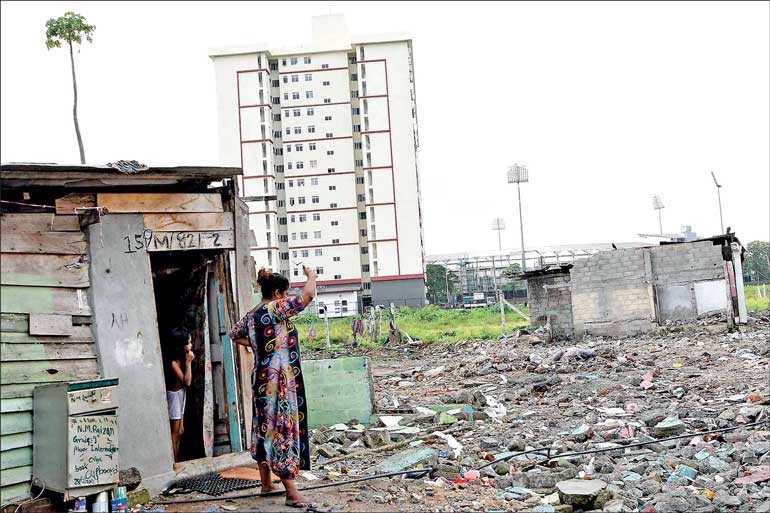Wednesday Oct 15, 2025
Wednesday Oct 15, 2025
Wednesday, 17 February 2021 00:00 - - {{hitsCtrl.values.hits}}

The main challenge we face in this journey to uplift rural Sri Lanka is the profit motive. As previously stated, real microfinance cannot be judged by its interest income or interest margin, it has to be judged by other, more qualitative factors. The real rewards are down the road: the inclusion of more Sri Lankans into the financial system creates a stronger and more robust economy – Pic by Shehan Gunasekara
 Rural development and self-employment are the most critical issues faced by developing countries. In Sri Lanka, over 80% of the population is considered to be ‘rural’ and significantly, the majority of this population consists of youth.
Rural development and self-employment are the most critical issues faced by developing countries. In Sri Lanka, over 80% of the population is considered to be ‘rural’ and significantly, the majority of this population consists of youth.
The lives of rural Sri Lankans have not improved or evolved substantially and opportunities for economic advancement are few and far between. Sri Lanka can never attain sustainable development until it improves key indicators amongst its rural population.
Crucially, the gap between the richest and the poorest is ever expanding. Rapid and geographically-concentrated urbanisation necessarily leads to a polarisation of a populace, eventually each segment becomes suspicious of the other, unable to reconcile the values of their counterparts.
Many in the working poor and underclass have already begun to notice that the upper middle class might spend more in a night at a restaurant than they may earn as monthly wages. As urban city-centres become beacons of opportunity, the rural countryside slips further into stagnation.
‘Gami Pubuduwa’
US President JFK wrote that “if the free society cannot help the many who are poor, it cannot save the few who are rich”. This quote was part of my introductory message to the ‘Gami Pubuduwa’ scheme which was launched by our team at HNB all the way back in May 1989 with the explicit purpose of providing the rural community with at least part of the multitude of banking facilities available to the urban community.
Our idea at HNB was to complement the uplifting of those living in rural areas, areas that are in dire need of accessible roads, formal education and health services. Credit is perhaps considered a villain in the context of the 2008 financial crisis and the numerous cases of fraud and delinquency. Yet without credit, many of the economic success stories of the past several decades would not have been possible. Upward social mobilisation, home-ownership, and entrepreneurship are just some facets of human development that simply would not exist if it were not for the concept of credit.
Throughout history, the rural population of Sri Lanka did not have access to credit or other banking facilities, they were denied opportunities for social advancement. ‘Gami Pubuduwa’ was meant to be a tool to enhance the financial inclusivity of the rural population and to harness the innate talents of the farmers and those with an entrepreneurial mindset.
As someone born in a small fishing village close to Hikkaduwa, I understood the challenges: the scheme would need to operate within the cultural and social constraints of the village. To achieve this, the ‘Gami Pubuduwa’ scheme could not be successfully managed as a centralised operation, it required an understanding of the economic and social dynamics at the grassroots level.
We invested heavily in field officers who were dubbed ‘Gami Pubudu Upadeshakas’ (GPUs). The GPU would become an integral part of this system and would counteract many of the issues that have been known to plague micro-credit schemes. The GPU would necessarily be involved in social, cultural, religious and educational activities and develop close interpersonal ties with the village.
The GPU must be able to identify the entrepreneurial spirit and meet their needs by advising the project, drawing up project proposals and fulfilling the documentation. I wrote in 1995 that the GPU is a multifaceted role; a friend, financier and advisor all in one. During this period the recovery rate of the ‘Gami Pubuduwa’ scheme was 97%.
Microcredit criticisms
Some of the criticisms or draw backs of microcredit are certainly legitimate. A poor household can very easily fall into a debt trap, especially since they may not possess sound financial management skills. Some try to hide expenses and borrow funds for consumption purposes.
Some schemes are simply ‘gini poli’ loans window dressed as microfinance schemes, charging exorbitant interest rates that necessarily encourage debt traps. Then there is the phenomenon of the informal intermediary who is usually also from the village but with significantly more access to funds. This intermediary, who will easily qualify for a loan will then redistribute the funds to villagers who are unable to qualify, but do so at high interest rates and thus become the ultimate beneficiary.
The GPU, as part of the ‘Gami Pubuduwa’ scheme, becomes essential to the system for many of the above critiques. The GPU will have knowledge of the local industries in the respective village, thus all facilities will only be approved for projects deemed viable. Whether it is farming or agricultural enterprise or small industry, the feasibility of the project is the foremost consideration. The GPU’s constant presence in the village will also deter the intermediaries.
In terms of interest rates, our scheme at HNB always applied an interest rate ceiling to ensure that the loans were not exploitative in anyway. Another important issue is that as these borrowers are outside the traditional credit system, they were not supposed to be entered into the CRIB, which makes it challenging to deter a borrower drawing funds from multiple schemes from different institutions. Once again it is the GPU that must be alive to the situation and as an added protection, borrowers are requested to sign a disclaimer that any additional borrowings will only be initiated following discussions with the GPU.
For some of the above restrictions to be lifted, we were lucky to have some broad minded individuals at the regulator who supported this vision. The former Governors of the CBSL; late Neville Karunathilake and A.S. Jayawardena saw the benefits such a scheme would bring to our nation’s economy.
It is also critical to understand that agricultural projects and other pursuits of those in the village are unlikely to pay off immediately. It is not simply a case of ensuring monthly repayment, following up on recoveries and executing a mortgage or reclaiming an asset. In the case of an agricultural project, there could be drought or floods, there may be other external factors that reduce prices on the market or there may be some disease or germ which infects the crop. In such cases, the facility should be rolled over for the next harvest period and not simply classified as a statistic.
Another issue for agri-businesses is the restrictive cost of transportation to market places and agri-centres which will then buy the produce from the farmer, often at wholesale prices, thus the farmer has virtually no margin when he deducts the cost of transportation. To counteract this, we tried to establish agricultural centres which would be in closer proximity to villages. These centres would act as collection and distribution hubs which, when scaled, would bring fresh produce to the market efficiently with a cost saving to the farmer.
Microfinance is no easy task
All of the above challenges show that microfinance is no easy task, if it were, the capitalist model would have certainly ensured vast and rapid growth of microfinance around the world. However the opposite is true: microfinance is complicated, requires resources, patience and a willingness to forego short-term profitability.
The various economic activities financed under the scheme aside from cultivation and agri-businesses include handicrafts, fisheries, light engineering, trading, construction material production, horticulture etc. The multiple avenues available provide a pathway to upward social mobilisation for the villager as well as the village.
More than a lending scheme, microfinance can inculcate a savings habit and is especially crucial to the development of women in rural areas, to provide them with financial independence and allow them the resources to advance themselves and their families. At one point, we at HNB had gathered a comparatively larger deposit base from the villages than we had envisioned.
The main challenge we face in this journey to uplift rural Sri Lanka is the profit motive. As previously stated, real microfinance cannot be judged by its interest income or interest margin, it has to be judged by other, more qualitative factors. The real rewards are down the road: the inclusion of more Sri Lankans into the financial system creates a stronger and more robust economy.
It is not much of a challenge nowadays for banks to lend to large corporates and mega Government infrastructure projects. Interest and fee income from trade and working capital facilities are steady and require little grassroots interaction. Microfinance is not the same, it cannot be looked upon as simply ‘finance’. It runs deeper, it requires a more measured approach and the subordination of the profit motive for the sake of the greater good.
This will be a major challenge for the private sector, but it is a challenge that if successfully met, can change our economic landscape and bring millions out of poverty and destitution, giving life to the hopes and dreams of the men and women that toil so hard for so little.
(The writer can be reached via [email protected])